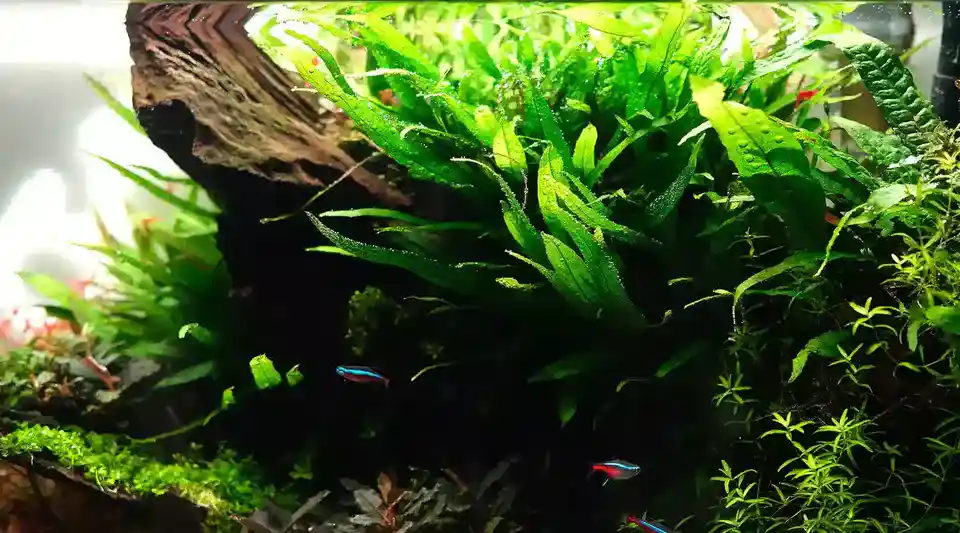If you’re looking to add an aquatic plant to your freshwater tank, Java Fern is an excellent choice. Not only is it aesthetically pleasing, but it’s also easy to care for, making it a perfect option for beginner aquarists. In this guide, we’ll take you through everything you need to know about planting Java Fern, from substrate and lighting requirements to propagation tips and troubleshooting.
Key Takeaways:
- Java Fern is an easy-to-care-for plant that’s perfect for beginner aquarists.
- Proper substrate and lighting are essential for successful Java Fern growth.
- Java Fern can be propagated through runners or division.
- Maintaining proper care can prevent common issues like algae growth or rotting roots.
- Java Fern is compatible with various tankmates and aquatic plants.
Understanding Java Fern: An Overview
Java Fern, scientifically known as Microsorum pteropus, is a popular aquatic plant species among aquarists. Due to its unique appearance and ease of care, it is commonly used as a focal point in freshwater tanks. Java Fern is native to Southeast Asia and can be found growing on various surfaces such as rocks, wood, and the river bottom.
Java Fern is highly adaptable and can thrive in a range of water conditions, making it an excellent choice for beginners. Its leaves are hard and sturdy, with a distinct shape that varies between different subspecies. The plant can grow up to 13 inches in height and 6 inches in width, depending on the conditions and environment.
Java Fern is considered a slow-growing plant, which means it requires little maintenance once established. It is also an ideal choice for aquariums with herbivorous fish, as its leaves are hard to eat and can withstand a moderate level of nibbling.
If you’re looking to add a natural-looking focal point to your freshwater tank, Java Fern is an excellent option that won’t break the bank. Its unique look and low-maintenance nature make it a perfect choice for any aquarist looking to add some green to their tank.

Preparing for Planting: Best Substrate and Lighting Requirements
If you want your Java Fern to thrive in your freshwater tank, it’s crucial to provide the best substrate and lighting conditions. Choosing the right substrate will allow the plant’s roots to anchor and absorb essential nutrients from the water column.
Best Substrate for Java Fern
When it comes to selecting the best substrate for Java Fern, it’s essential to choose a material that won’t break down quickly. A combination of small gravel and peat moss can provide the ideal substrate. The peat moss will anchor the plant’s roots while slowly releasing organic nutrients into the water column.
Another substrate material worth considering is an aquatic plant soil, which can provide the necessary nutrients for the plant’s growth. However, this may require the addition of root tabs to ensure the plant receives sufficient nourishment.
Java Fern Lighting Requirements
Java Fern is a relatively low-light plant, but it still requires adequate light for photosynthesis to occur. It’s essential to avoid placing it in direct sunlight, as this can lead to an overgrowth of algae and damage to the plant.
The ideal lighting condition for Java Fern is low to medium intensity, with a range of 2-4 watts per gallon of water. LED lights are a popular choice for aquarium plant lighting and can provide the perfect balance of light intensity and spectrum.
Keep an eye on the plant’s growth and adjust the lighting conditions accordingly. If the leaves start to yellow, the plant may be receiving too much light. Conversely, if the leaves are growing long and thin, it may indicate insufficient light.
Planting Java Fern: Step-by-Step Guide
If you’re ready to add Java Fern to your aquarium, here’s a step-by-step guide to ensure successful planting:
- Prepare the substrate: Java Fern can grow in a variety of substrates, including sand, gravel, and rocks. Ensure the substrate is clean and rinsed before planting.
- Choose the location: Java Fern can be attached to rocks or driftwood, or planted directly into the substrate. Choose a location that has low to moderate water flow and is well-lit.
- Attach Java Fern to rocks or driftwood: Java Fern can be attached to rocks or driftwood using a thin thread or fishing line. Be careful not to tie the thread too tightly, as this can damage the plant.
- Plant Java Fern directly into the substrate: If planting Java Fern directly into the substrate, use planting tweezers to carefully bury the roots while ensuring the rhizome remains above the substrate. Avoid burying the entire plant into the substrate, as this can lead to root rot.
- Maintain the plant: Java Fern requires low to moderate lighting and can thrive in a wide range of water conditions. Ensure the water temperature is between 68 and 82 degrees Fahrenheit, and keep the pH between 6 and 7.5. Supplement the plant with additional nutrients if necessary.
- Monitor for growth: Java Fern grows at a slow pace, so be patient and monitor the plant’s progress. As the plant grows, ensure it doesn’t overcrowd other aquatic plants or block the flow of water.
By following these simple steps, you can successfully plant Java Fern and watch it thrive in your aquarium. Remember, Java Fern is a low-maintenance plant that requires minimal care, making it an ideal choice for beginner aquarists.
Java Fern Propagation: Tips for Success
Java Fern is an incredibly versatile plant that can be propagated in several ways. Here are some tips to help you achieve successful propagation:
Method 1: Rhizome Division
One of the easiest methods of propagation is through rhizome division. First, remove the Java Fern from its current spot, and gently pull apart the rhizome into smaller pieces. Be sure to leave a few leaves on each piece. These smaller segments can then be planted in a new location, allowing for new growth to take place. This method is best done during spring or summer when the plant is actively growing.
Method 2: Water Propagation
Another method of propagation is through water propagation. First, you need to cut a healthy leaf from the Java Fern and place it in a jar of water. Ensure that the leaf is submerged and that it receives enough sunlight. After a week or two, small roots and shoots will start to emerge from the base of the leaf. Once the roots are at least an inch long, you can plant the leaf in a substrate.
Method 3: Spores
If you want to propagate Java Fern using spores, you can do so by allowing the plant to produce spores. First, remove a healthy leaf and place it on top of a piece of paper or cloth. The spores will fall off the leaf and onto the paper. You can then use a brush to transfer the spores to a new location, where they can grow into new plants.
Regardless of the propagation method you choose, it’s important to provide optimal growing conditions to ensure successful propagation. Java Fern prefers low to moderate light and a slightly acidic pH between 6.0 and 7.5. Ensure that the water doesn’t contain excessive amounts of ammonia or nitrate, which can harm the plant. With the right care and attention, Java Fern can quickly grow and reproduce in your aquarium.
Maintaining Java Fern: Care and Troubleshooting Tips
Java Fern is a low-maintenance plant, but it still requires some care to ensure healthy growth in your aquarium. Here are some essential tips to keep in mind:
Cleaning
Regular cleaning is necessary to prevent the accumulation of algae and debris on the leaves. Use a soft brush or cloth to gently wipe the leaves. Avoid using any abrasive material or chemicals that may damage the plant or the aquarium ecosystem.
Pruning
Java Fern grows slowly, but it may still need pruning from time to time to remove damaged or dead leaves. Use a pair of scissors to cut the affected leaves at the base, close to the stem. Be careful not to disturb the root system or cut healthy leaves.
Water Conditions
Java Fern thrives in neutral to slightly alkaline water with a pH range of 6.0 to 7.5. Make sure to test the water quality regularly and adjust the pH, temperature, and lighting as needed. Avoid sudden changes in the water parameters, as they may shock the plant and harm the fish.
Lighting
Java Fern prefers moderate to low lighting, as direct sunlight may cause the leaves to burn. Use a timer to regulate the lighting duration and intensity, and provide at least 8 to 10 hours of light per day.
Common Issues and Troubleshooting
Yellow Leaves: Yellowing leaves are a sign of nutrient deficiency or too much light. Try adding some root tabs or liquid fertilizers to the substrate, or adjust the lighting intensity by moving the plant to a different location or reducing the duration.
Brown Spots: Brown spots may indicate bacterial or fungal infection, or too much organic waste in the water. Increase the water changes and cleaning frequency, and add some aquarium salt or medication if needed.
By following these maintenance tips, you can enjoy the beauty and benefits of Java Fern for years to come. Happy planting!
Creating a Thriving Aquatic Habitat: Java Fern and Tankmates
If you want to create a thriving aquatic habitat, adding Java Fern to your aquarium is a great start. Its lush green leaves and hardy nature make it a popular choice for aquarium enthusiasts. But how compatible is it with other aquatic plants and fish?
Java Fern is a slow-grower and requires low to moderate lighting, which makes it an excellent addition to any freshwater tank. It is also resilient and can tolerate a wide range of water conditions, making it a great choice for beginners.
Compatible Tankmates
Java Fern is known to be compatible with a variety of freshwater fish and invertebrates. Some popular choices include:
- Betta fish
- Guppies
- Tetras
- Shrimp
- Snails
However, it is important to keep in mind that some fish may nibble on the leaves of Java Fern, which could damage or kill the plant. Additionally, large cichlids have been known to uproot Java Fern, so it may not be the best choice for tanks with aggressive fish.
Compatible Aquatic Plants
If you’re looking to create a lush aquatic landscape, Java Fern pairs well with a variety of other freshwater plants. Some popular choices include:
- Anubias
- Bolbitis
- Cryptocoryne
- Mosses
- Swords
When positioning your plants, be sure to give each enough space to grow and thrive. Avoid planting Java Fern too close to other plants, as it could potentially block out the light they need to grow.
Adding Java Fern to your aquarium is a great way to create a beautiful and thriving aquatic habitat. With the right tankmates and aquatic plants, your aquarium can become a stunning underwater oasis.
Conclusion: Unleash Your Green Thumb with Java Fern
Whether you’re an experienced aquarist or a beginner, adding Java Fern to your freshwater tank can be a great way to enhance the beauty of your aquatic habitat. Not only does it add a pop of lush green to your tank, but it also offers numerous benefits to the ecosystem.
With its low-maintenance requirements and compatibility with various aquatic species, planting Java Fern is a great choice for anyone looking to incorporate beautiful, healthy plants into their aquariums.
If you’re just getting started, follow our step-by-step guide to planting Java Fern and get ready to enjoy this stunning addition to your tank. Remember to choose the best substrate and lighting requirements, propagate the fern successfully, and troubleshoot any common issues that may arise during maintenance.
With these tips, you can create a thriving aquatic habitat that will not only be a joy to look at but also benefit the health of your fish and other aquatic species. So why wait? Unleash your green thumb today with Java Fern and watch your aquarium come to life!













Comments are closed.